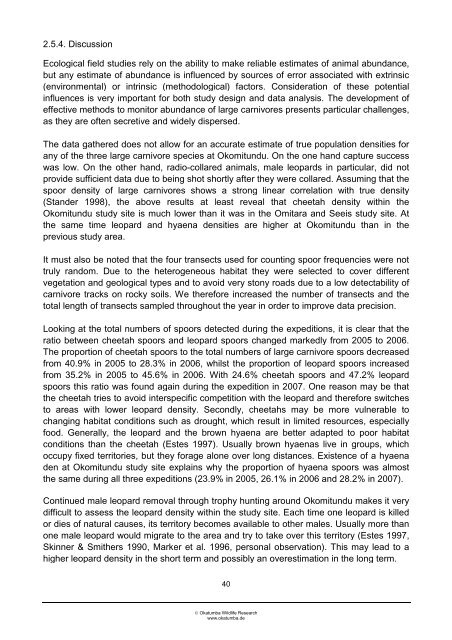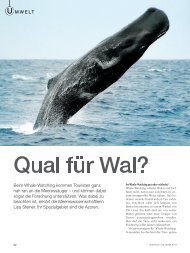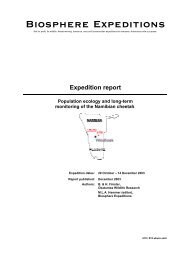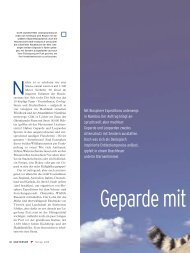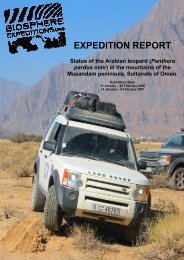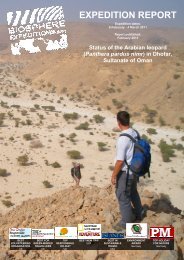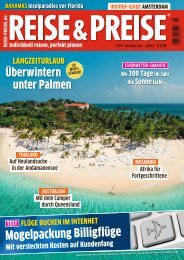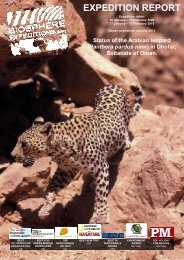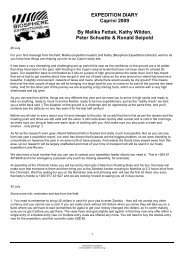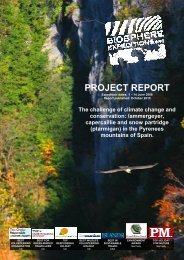EXPEDITION REPORT - Biosphere Expeditions
EXPEDITION REPORT - Biosphere Expeditions
EXPEDITION REPORT - Biosphere Expeditions
Create successful ePaper yourself
Turn your PDF publications into a flip-book with our unique Google optimized e-Paper software.
2.5.4. Discussion<br />
Ecological field studies rely on the ability to make reliable estimates of animal abundance,<br />
but any estimate of abundance is influenced by sources of error associated with extrinsic<br />
(environmental) or intrinsic (methodological) factors. Consideration of these potential<br />
influences is very important for both study design and data analysis. The development of<br />
effective methods to monitor abundance of large carnivores presents particular challenges,<br />
as they are often secretive and widely dispersed.<br />
The data gathered does not allow for an accurate estimate of true population densities for<br />
any of the three large carnivore species at Okomitundu. On the one hand capture success<br />
was low. On the other hand, radio-collared animals, male leopards in particular, did not<br />
provide sufficient data due to being shot shortly after they were collared. Assuming that the<br />
spoor density of large carnivores shows a strong linear correlation with true density<br />
(Stander 1998), the above results at least reveal that cheetah density within the<br />
Okomitundu study site is much lower than it was in the Omitara and Seeis study site. At<br />
the same time leopard and hyaena densities are higher at Okomitundu than in the<br />
previous study area.<br />
It must also be noted that the four transects used for counting spoor frequencies were not<br />
truly random. Due to the heterogeneous habitat they were selected to cover different<br />
vegetation and geological types and to avoid very stony roads due to a low detectability of<br />
carnivore tracks on rocky soils. We therefore increased the number of transects and the<br />
total length of transects sampled throughout the year in order to improve data precision.<br />
Looking at the total numbers of spoors detected during the expeditions, it is clear that the<br />
ratio between cheetah spoors and leopard spoors changed markedly from 2005 to 2006.<br />
The proportion of cheetah spoors to the total numbers of large carnivore spoors decreased<br />
from 40.9% in 2005 to 28.3% in 2006, whilst the proportion of leopard spoors increased<br />
from 35.2% in 2005 to 45.6% in 2006. With 24.6% cheetah spoors and 47.2% leopard<br />
spoors this ratio was found again during the expedition in 2007. One reason may be that<br />
the cheetah tries to avoid interspecific competition with the leopard and therefore switches<br />
to areas with lower leopard density. Secondly, cheetahs may be more vulnerable to<br />
changing habitat conditions such as drought, which result in limited resources, especially<br />
food. Generally, the leopard and the brown hyaena are better adapted to poor habitat<br />
conditions than the cheetah (Estes 1997). Usually brown hyaenas live in groups, which<br />
occupy fixed territories, but they forage alone over long distances. Existence of a hyaena<br />
den at Okomitundu study site explains why the proportion of hyaena spoors was almost<br />
the same during all three expeditions (23.9% in 2005, 26.1% in 2006 and 28.2% in 2007).<br />
Continued male leopard removal through trophy hunting around Okomitundu makes it very<br />
difficult to assess the leopard density within the study site. Each time one leopard is killed<br />
or dies of natural causes, its territory becomes available to other males. Usually more than<br />
one male leopard would migrate to the area and try to take over this territory (Estes 1997,<br />
Skinner & Smithers 1990, Marker et al. 1996, personal observation). This may lead to a<br />
higher leopard density in the short term and possibly an overestimation in the long term.<br />
40<br />
� Okatumba Wildlife Research<br />
www.okatumba.de


